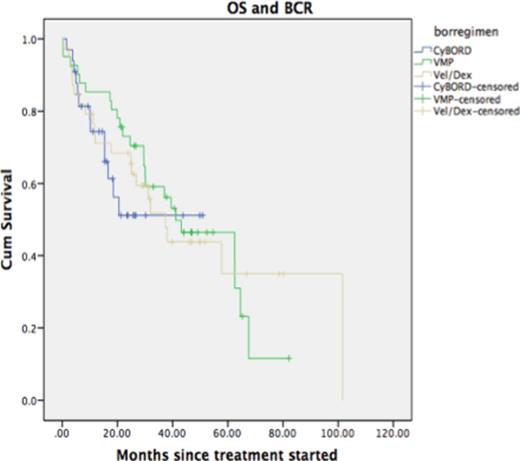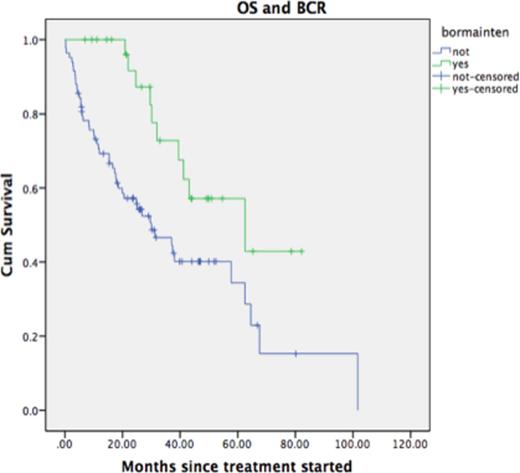Abstract
Introduction In patients not eligible for transplant due to age and/or co-morbidities, the selection of up-front therapy needs to balance efficacy and toxicity. Recently, regimens with bortezomib, a proteasome inhibitor proven to be efficacious in myeloma, have been reported. Based on these findings, we aimed to evaluate the impact of different bortezomib combinations for the treatment of non transplant-eligible MM.
Methods All- consecutive patients treated with bortezomib-containing regimens (BCR) at Tom Baker Cancer Center (TBCC) from 01/2006 to June/2015 were evaluated. Definitions of response and progression were used according to the EBMT modified criteria and a category of very good partial response (VGPR) was added. Two-sided Fisher exact test was used to test for differences between categorical variables. A p value of <0.05 was considered significant. Survival curves were constructed according to the Kaplan-Meier method and compared using the log rank test.
Results 113 consecutive patients with MM received BCR. Thirty-three patients were treated with cyclophosphamide, bortezomib and dexamethasone (CyBorD), 41 with bortezomib, melphalan and prednisone (VMP) and 39 with bortezomib and dexamethasone (VD). Clinical characteristics are shown in Table 1. At the time of analysis, 20, 17 and 18 patients in the CyBorD, VMP and VD groups are still alive and 14, 33 and 30 have already progressed, respectively. ORR and VGPR rates were 93.9%/75.7%, 80%/53% and 76%/48% (p=0.001) for patients treated with CyBorD, VMP and VD, respectively. Median OS was NR for CyBorD, compared to 41months and 37 months for VMP and VD patients (p=0.6). Median PFS was 16.7 months for CyBorD compared to 17.5 months and 11 months for VMP and VD (P=0.6), respectively. The rate of treatment discontinuation and median number of cycles were: 9%, 26% and 12.8% and 6, 7.5 and 4 cycles for CyBorD, VMP and VD patients, respectively. Patients were to receive 6-9 cycles of treatment and the regimen could be continued to a maximum of 2 years at the discretion of the treating hematologist based on tolerability and response. Nine patients (27%) in the CyBorD group and 17 (41.4%) and 4 (10%) in the VMP and VD group received maintenance treatment. Median OS and PFS was longer for the group receiving maintenance (62 months vs 32 months and 23 months vs 10 months, p=0.007).
In conclusion, bortezomib containing regimens are efficacious in the treatment of non-transplant eligible MM. Patients receiving maintenance appeared to exhibit longer PFS and OS. Very elderly patients should be subjected to frailty and comorbidity indexes aiming to decrease toxicity and prolong survival.
Clinical Characteristics
| Characteristic . | CyBorD, n=33 . | VMP, n=41 . | VD, n=39 . |
|---|---|---|---|
| Age (median) | 58 | 58 | 58 |
| Gender Male Female | 20 (60.6%) 13 (39.4%) | 22 (53.6%) 19 (46.4%) | 26 (66.6%) 13 (33.4%) |
| Hb (g/L) | 107 | 110 | 103 |
| Calcium (µmol/L) | 2.4 | 2.35 | 2.31 |
| Creatinine (µmol/L) | 115.5 | 103 | 108 |
| B2microglobulin (µmol/L) | 4.1 | 3.42 | 5.9 |
| Albumin (g/L) | 31 | 31 | 30 |
| Stage I Stage II Stage III | 6 (12.1%) 14 (42.4%) 13 (45.5%) | 9 (21.9%) 19 (46.3%) 13 (31.8%) | 4 (10.2%) 16 (41%) 18 (48.8%) |
| LDH (IU/L) | 185 | 179 | 174 |
| BMPC (%) | 31 | 30 | 33.5 |
| Heavy chain: IgG IgA FLC only IgD IgM Biclonal | 22 4 7 0 0 0 | 19 14 8 0 0 0 | 21 10 7 0 1 0 |
| Light chain: Kappa Lambda Biclonal | 16 17 0 | 29 12 0 | 24 15 0 |
| High risk Standard risk | 5 (15%) 28 | 6 (14.6%) 35 | 8 (20%) 31 |
| Characteristic . | CyBorD, n=33 . | VMP, n=41 . | VD, n=39 . |
|---|---|---|---|
| Age (median) | 58 | 58 | 58 |
| Gender Male Female | 20 (60.6%) 13 (39.4%) | 22 (53.6%) 19 (46.4%) | 26 (66.6%) 13 (33.4%) |
| Hb (g/L) | 107 | 110 | 103 |
| Calcium (µmol/L) | 2.4 | 2.35 | 2.31 |
| Creatinine (µmol/L) | 115.5 | 103 | 108 |
| B2microglobulin (µmol/L) | 4.1 | 3.42 | 5.9 |
| Albumin (g/L) | 31 | 31 | 30 |
| Stage I Stage II Stage III | 6 (12.1%) 14 (42.4%) 13 (45.5%) | 9 (21.9%) 19 (46.3%) 13 (31.8%) | 4 (10.2%) 16 (41%) 18 (48.8%) |
| LDH (IU/L) | 185 | 179 | 174 |
| BMPC (%) | 31 | 30 | 33.5 |
| Heavy chain: IgG IgA FLC only IgD IgM Biclonal | 22 4 7 0 0 0 | 19 14 8 0 0 0 | 21 10 7 0 1 0 |
| Light chain: Kappa Lambda Biclonal | 16 17 0 | 29 12 0 | 24 15 0 |
| High risk Standard risk | 5 (15%) 28 | 6 (14.6%) 35 | 8 (20%) 31 |
Ab: BMPC: Bone marrow plasma cells.
Progression-Free survival for patients receiving CyBorD, VMP and VD
Jimenez-Zepeda:Celgene: Honoraria; Amgen: Honoraria; J&J: Honoraria. Duggan:Jansen: Honoraria; Celgene: Honoraria. Neri:Celgene: Research Funding. Bahlis:Johnson & Johnson: Speakers Bureau; Johnson & Johnson: Consultancy; Amgen: Consultancy; Johnson & Johnson: Research Funding; Celgene: Consultancy, Honoraria, Research Funding, Speakers Bureau.
Author notes
Asterisk with author names denotes non-ASH members.




This feature is available to Subscribers Only
Sign In or Create an Account Close Modal